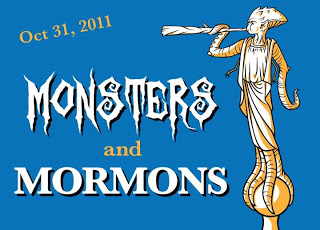 The last two days I have been attending Sunstone Symposium in Salt Lake City. Sunstone is an annual gathering of more progressive Mormons who explore various facets of what it means to be a Mormon wrestling seriously with troubling historical, doctrinal, and social issues. I often find the conference very interesting in my research in Mormon studies and interreligious dialogue. This year a presentation caught my interest that seemed very different from many of the offerings. It was “‘I’m a Half-Druid Elf Going to the Steampunk Ball!’ Comic Cons, Cosplay, Roleplaying Games, and Mormons” by Doe Daughtrey. Daughtrey has a PhD in religious studies, and previously I have enjoyed her research into syncretistic Mormons who combine aspects of Mormonism with the Western esoteric tradition, such as the “New Age” and Wicca.
The last two days I have been attending Sunstone Symposium in Salt Lake City. Sunstone is an annual gathering of more progressive Mormons who explore various facets of what it means to be a Mormon wrestling seriously with troubling historical, doctrinal, and social issues. I often find the conference very interesting in my research in Mormon studies and interreligious dialogue. This year a presentation caught my interest that seemed very different from many of the offerings. It was “‘I’m a Half-Druid Elf Going to the Steampunk Ball!’ Comic Cons, Cosplay, Roleplaying Games, and Mormons” by Doe Daughtrey. Daughtrey has a PhD in religious studies, and previously I have enjoyed her research into syncretistic Mormons who combine aspects of Mormonism with the Western esoteric tradition, such as the “New Age” and Wicca.
This seminar represented a new interest for Daughtrey, who is also a friend of mine, and who now shares an additional research interest with me in terms of the religious aspects of the fantastic in popular culture. The abstract for this presentation reads:
Like many Americans, Mormons play video and tabletop roleplaying games, attend and contribute to comic and sci-fi fantasy conventions, and even engage in cosplay (adult dressup). This presentation explores the ways Mormon concepts of embodiment inform Church members’ participation in game play and Con-culture, focusing on religion-related concerns about gender, body image, morality, time management, addiction and obsessive-compulsive behavior, and personal health and hygiene.
I have explored the Mormon connection to the fantastic previously, such as the large number of Mormon writers contributing to science fiction, and the Mormon elements within Battlestar Galactica, and Twilight. However, Daughtrey’s research proposal adds a new dimension to this line of research. For me two elements were most noteworthy in the discussion. First, Daughtrey suggests that Mormons may be significantly represented in gaming (video and roleplay) and other aspects of the fantastic such as cosplay, in contrast with other religious traditions. This may be in light of the fantastic elements of Mormon cosmology that dovetail with science fiction narratives, thus contributing to the overrepresentation of Mormons in science fiction authorship in comparison with other religious traditions. But such conclusions will need to be supported by future ethnographic research. Second, Daughtrey suggests that there are a variety of reason why Mormons are so drawn to cons, cosplay, and roleplaying games. The significance of the body and roleplaying within Mormon culture translates quite easily to alternative expressions outside of Mormonism. For example, Mormons take on roles as they perform rituals in the temple as an important part of learning what it means to be divine in their quest for exalation. Although a very different type of roleplaying takes place in video games or fantasy roleplaying games, nevertheless these differing expressions of roleplaying have significant overlap for Mormon participants.
I wish Daughtrey well in this research project and hope to report on future aspects of it as it develops in the future.





There are no responses yet